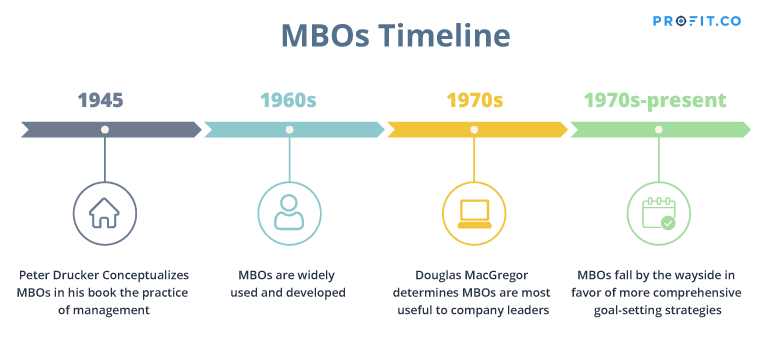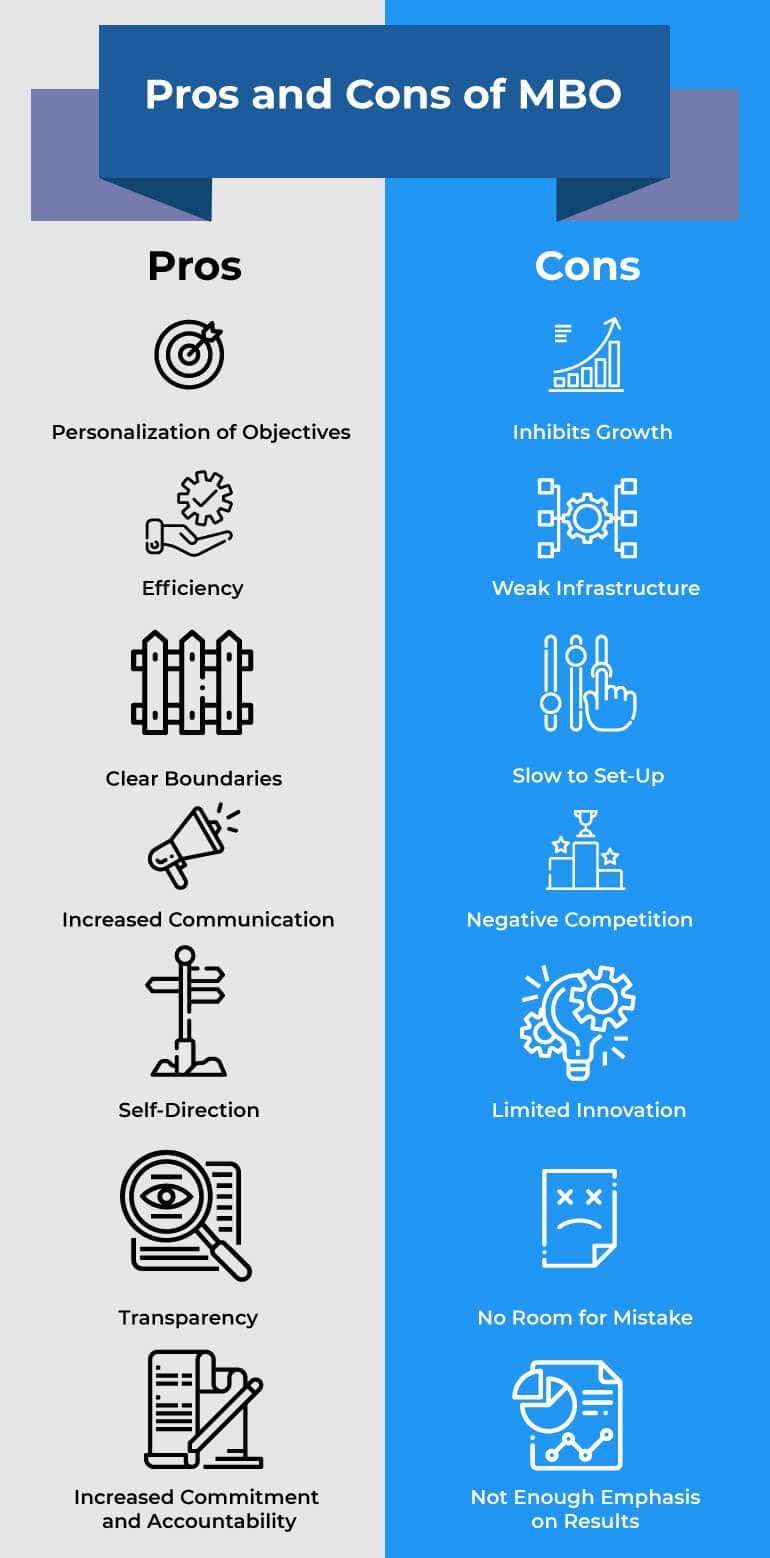

Organizations of all kinds need effective management frameworks to follow in order to best reach their individual goals. Management by Objectives is one such framework that aims to create a cohesive communication between all associates within a company, from the management to the employees.
Most impossible goals can be met simply by breaking them down into bite size chunks, writing them down, believing them and going full speed ahead as if they were routine.
Don Lancaster, American authorManagement by Objectives, also known as MBOs, is a strategic model used by organizations to clearly outline specific objectives and major company goals that are agreed upon by both management and employees. The process of MBOs consists of five steps that aim to enhance performance.
In this article we will explore the origin of MBOs and the key steps within its process. We will also discuss other components on MBOs such as the three types of objectives, the pros and cons of this strategy, examine real life examples, and dissect how MBOs compares to other modern performance management system.
The Origin of MBOs

The theory of Management by Objectives was first described by Peter Drucker in 1954 in his book The Practice of Management. This original outline was further developed throughout the 1950s to 1970s, which was also the timeframe in which it was most commonly used.
The Management by Objectives model runs off the principle that a company’s effectiveness is a more important skill than its efficiency. This puts a focus of management on the quality of performance rather than speed. One of the later developers of the model, Douglas MacGregor, insisted that MBO as a system was better at helping the superiors of a company more effectively assess their subordinates.
After the 70’s, however, widespread usage of MBO largely decreased, especially as new styles and systems of management began to be developed. There was some critique that MBO was simply not a comprehensive enough system of management, especially in the sense of MBO being too short-sighted, according to HR Zone.
Has MBO Become Obsolete?
Despite its fall from popularity, MBO is still a system of management that is utilized, either in whole or in part, by many companies. There are many principles laid out within MBO that can be seen echoed through more modern management styles, as MBO focuses tightly on the core aspects of performance management.
As such, MBO is still an important management model to examine for companies today. The principles outlined have the potential to work as solid tools within a broader scope of knowledge about management styles.
The Key Steps and Components of MBO
The MBO system is defined by five steps, but there are actually a few additional components to consider. Each of these do come into play in the steps but may require extra attention or reorganizing in the event that the system seems to be non-effective.
These additional components are the types of MBO objectives, quantification of objectives, and performance appraisals. Each of these contributes not only to the success of MBO but to the greater organizational understanding of the wants and needs of a company.
The Five Steps
1. Set Company Objectives: A company’s management team must identify clear and measurable goals that are within a reasonable realm of achievement and align with the company’s mission, ideals, and ethics.
2. Translate Objectives to Employees: The objectives, once decided upon, must then be delivered to and aligned with employees of the company.
3. Employees Set Individual Objectives: Once given the broad company-oriented objectives, employees should plan their own personal objectives that will help them to arrive at the larger company goal
4. Monitoring of Employees: The employees are now monitored by management for how well they perform and deliver on both the agreed upon individual and company objectives.
5. Evaluation: The final step is an evaluation and provision of feedback for employees by management. Those doing well and staying on track with the objectives are rewarding, providing incentive for employees to stay focused and work hard.
The 3 Types of Objectives
Generally speaking, objectives within any sort of strategic management can be divided into three overarching categories. These apply to MBOs objectives, but they can also apply to objectives in different management systems and scenarios as well. They are as follows:
1. Strategic Objectives: These are the broad, all-encompassing objectives determined by company management in step one. These should always be set first and then used to determine later objectives.
2. Tactical (Team) Objectives: These are more specific objectives within a company that set groups or teams should work towards accomplishing. This can include tasks that require teams from different departments to intersect and collaborate to achieve a common goal.
3. Operational (Individual) Objectives: These are highly-specific goals that belong to either an individual employee or to a singular department. These objectives will vary greatly from person to person depending on what their overall role in the larger objective is.
Quantification of Objectives
Quantification of objectives is providing a clear outlining and definition of the requirements of the specified objective. This can be simplified by the use of the acronym SMART, which means:
Performance Appraisals
The final step involved in MBO are the performance appraisals, or evaluations. Like the other components, there are multiple layers to a performance appraisal that must be considered in order for them to be effective, such as:

Pros and Cons of MBO
Arguments both for and against MBO exist today. As mentioned earlier, some critiques of MBO include the idea that the system is too short-sighted in terms of business growth and productivity. This is due to limitations brought on by setting objectives too strictly and not allowing for natural innovation amongst employees.
“With pre-established goals and descriptions, little weight can be given to the areas of discretion open to the individual but not incorporated into a job description or objectives”
However, others argue that when MBO is used as a tool within a larger and more comprehensive management plan, it can greatly help to simplify management and optimize it for efficiency.
The truth of the matter is the MBO comes with both advantages and disadvantageous. Being aware of its strengths and weaknesses is key in utilizing the system as effectively as possible. Below are outlined the main pros and cons of Management by Objectives:
Real-World MBO Examples
There are many fields that can utilize and potentially benefit from MBO. Here are some real-world examples of how MBO can be used:
In truth, all aspects of a company – from human resources to marketing to sales to information technology and everything in between – can benefit from clear objective setting in areas where the company may currently fall short.
How MBO Compares to Alternatives
MBO paved the way for many modern-day and commonly used management systems. Here are three popular alternative styles and systems of management and a brief description of what they entail:
Final Thoughts
Though Management by Objectives is a bit outdated, it can serve as a great foundational point and tool within a larger toolkit for many companies looking to improve their style of management. MBO focuses on objectives and setting up employees for high productivity and success. Management teams should just be wary of becoming too narrow-sighted when using MBO and stay alert to potential complications that may arise. Additionally, integrating MBO with modern performance management software can enhance its effectiveness by leveraging technology to track, monitor, and evaluate objectives more efficiently.